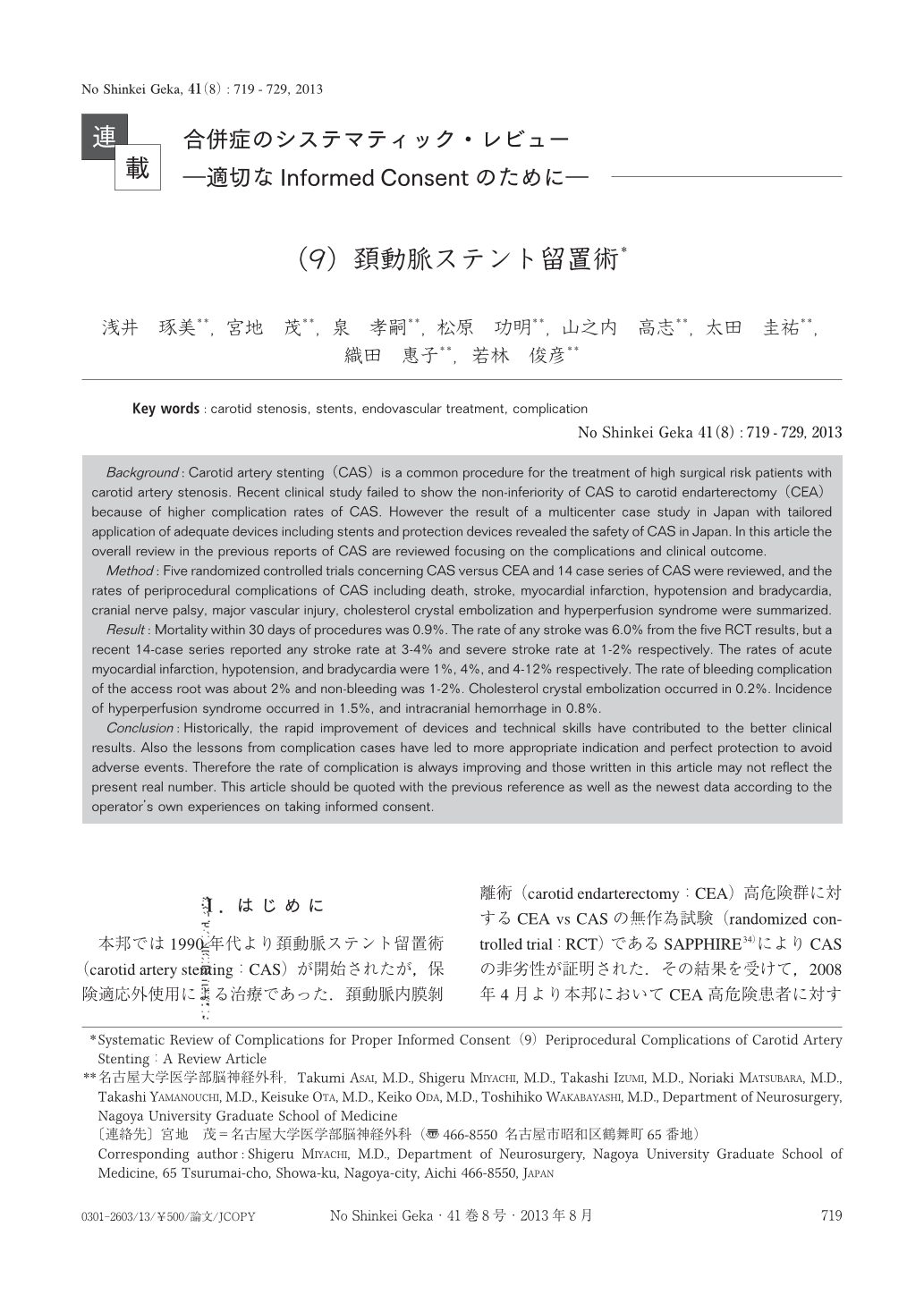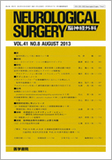Japanese
English
- 有料閲覧
- Abstract 文献概要
- 1ページ目 Look Inside
- 参考文献 Reference
Ⅰ.はじめに
本邦では1990年代より頚動脈ステント留置術(carotid artery stenting:CAS)が開始されたが,保険適応外使用による治療であった.頚動脈内膜剝離術(carotid endarterectomy:CEA)高危険群に対するCEA vs CASの無作為試験(randomized controlled trial:RCT)であるSAPPHIRE34)によりCASの非劣性が証明された.その結果を受けて,2008年4月より本邦においてCEA高危険患者に対するCASが保険収載され,本邦におけるCAS症例数は増加した.しかし,当初導入されたデバイスは,特にプロテクション性能の問題から,使用初期にわれわれは多くの合併症を経験した.さらに同時期にヨーロッパから発表された3つのRCT(EVA-3S18),SPACE31),ICSS16))の結果では,CAS群で有害事象が有意に多く,CAS施行を慎重に検討しなければならない状況となった.2009年以降,複数のメーカーから異なるデザインのステントや塞栓保護デバイスが続々とリリースされ,病変の特性やプラーク量・性状などによりデバイスを使い分けるtailored CASが行われるようになった.MiyachiらによるJapanese CAS survey(JCS)22)は本邦のCAS施行時期を3期(第1期:CAS承認前,第2期:CAS承認後,第3期:マルチデバイス時代)に分類し,第3期の成績が有意に良好であり,本邦におけるtailored CASの有用性を報告している.また,2010年にCREST6)によりCASのCEAに対する非劣性が証明され,再びCASの治療効果に期待が集まるようになった.
今回は主として,前述したRCTを対象としてCAS合併症に焦点を当てて文献レビューおよび考察を行った.この領域は技術およびデバイスの進歩に伴って治療成績が改善していくため,現状を反映している比較的最近のcase series(CS)についても検討を行った.
本稿のレビューにおいて検討した各文献間には対象症例,患者背景,使用デバイス,合併症の定義などの差異があるため,結果をまとめて解釈することには注意が必要である.個々の患者につき合併症頻度などを検討する際には,参考文献を参照いただきたい.
Background:Carotid artery stenting(CAS)is a common procedure for the treatment of high surgical risk patients with carotid artery stenosis. Recent clinical study failed to show the non-inferiority of CAS to carotid endarterectomy(CEA)because of higher complication rates of CAS. However the result of a multicenter case study in Japan with tailored application of adequate devices including stents and protection devices revealed the safety of CAS in Japan. In this article the overall review in the previous reports of CAS are reviewed focusing on the complications and clinical outcome.
Method:Five randomized controlled trials concerning CAS versus CEA and 14 case series of CAS were reviewed, and the rates of periprocedural complications of CAS including death, stroke, myocardial infarction, hypotension and bradycardia, cranial nerve palsy, major vascular injury, cholesterol crystal embolization and hyperperfusion syndrome were summarized.
Result:Mortality within 30 days of procedures was 0.9%. The rate of any stroke was 6.0% from the five RCT results, but a recent 14-case series reported any stroke rate at 3-4% and severe stroke rate at 1-2% respectively. The rates of acute myocardial infarction, hypotension, and bradycardia were 1%, 4%, and 4-12% respectively. The rate of bleeding complication of the access root was about 2% and non-bleeding was 1-2%. Cholesterol crystal embolization occurred in 0.2%. Incidence of hyperperfusion syndrome occurred in 1.5%, and intracranial hemorrhage in 0.8%.
Conclusion:Historically, the rapid improvement of devices and technical skills have contributed to the better clinical results. Also the lessons from complication cases have led to more appropriate indication and perfect protection to avoid adverse events. Therefore the rate of complication is always improving and those written in this article may not reflect the present real number. This article should be quoted with the previous reference as well as the newest data according to the operator's own experiences on taking informed consent.

Copyright © 2013, Igaku-Shoin Ltd. All rights reserved.


